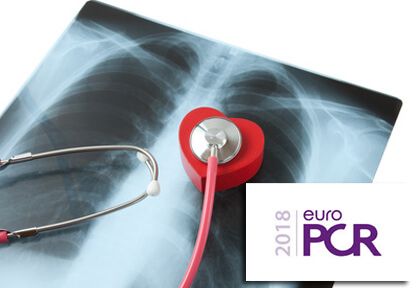The index of microcirculatory resistance might guide therapy and controlled intermittent coronary sinus occlusions, improve microvascular function, and reduce infarct size. This study included patients with prior ST-segment elevation myocardial infarction treated with primary angioplasty. Researchers measured the index of microcirculatory resistance before stenting and intermittent coronary sinus occlusion was used if the result was…
EuroPCR 2018 | SEMPER-FI: The Reemergence of the Intra-Aortic Balloon Counterpulsation
The intra-aortic balloon counterpulsation affects patients through a combination of coronary flow improvement and afterload reduction. It has been the subject matter of several studies, but its benefit as mechanical support has not been proven. This work aims to prove the benefits of balloon counterpulsation in patients with ST-segment elevation acute myocardial infarction who, after…
EuroPCR 2018 | Swedish Registry on the SYNERGY DES: tested in primary PCI for the first time
The study included 36292 consecutive patients undergoing acute myocardial infarction receiving PCI with the new generation stent SYNERGY (thin struts, bioresorbable polymer and everolimus eluting); 39.7% presented ST elevation MI. Kaplan-Meier curves at 2 years of patients receiving the SYNERGY vs patients receiving other drug eluting stents resulted very similar for thrombosis (0,69% vs 0,81%,…
EuroPCR 2018 | Compare-Acute: FFR or Primary Angioplasty at a 2-Year Follow-Up After Complete Revascularization
Recent studies in patients undergoing acute myocardial infarction showed that a complete revascularization strategy in an acute or subacute setting, whether it be guided through angiography (PRAMI, CvLPRIT) or fractional flow reserve (FFR) (PRIMULTI, COMPARE-ACUTE), improves the combined endpoint of major adverse cardiac events (MACE) when compared with treatment of the culprit artery only. Based…
EuroPCR 2018 | FFR Reduces Death and Infarction Rates Compared with Medical Treatment
Pooled data from the most important recently published studies (FAME 2, Compare-Acute, and DANAMI3-PRIMULTI) conclude that there is a significant difference in favor of fractional flow reserve (FFR) as regards hard endpoints. Coronary revascularization guided by FFR reduces the risk of death and infarction when compared with optimal medical treatment in patients with stable and…
Elderly Patients with ACS: Clopidogrel or Reduced-Dose Prasugrel?
Elderly patients are at elevated risk of both ischemic and bleeding complications after an acute coronary syndrome (ACS), and display higher platelet reactivity under clopidogrel when compared to younger patients. A 5-mg dose of prasugrel would provide more predictable platelet inhibition than clopidogrel in elderly populations, without the risk of bleeding entailed by the full…
Peri-Procedural Infarction: More Frequent than and Not as Innocent as We Thought
Almost 30% of all patients experience some degree of myocardial injury after elective angioplasty, a statistic associated to an increase in cardiovascular events at 30 days and 1 year, according to this study recently published in Eur Heart J. The study only included consecutive patients who underwent elective angioplasty with a negative troponin level at admission. The…
Peri-Procedural Infarction: More Frequent than and Not as Innocent as We Thought
Almost 30% of all patients experience some degree of myocardial injury after elective angioplasty, a statistic associated to an increase in cardiovascular events at 30 days and 1 year, according to this study recently published in Eur Heart J. The study only included consecutive patients who underwent elective angioplasty with a negative troponin level at admission. The…
ACC 2018 | Risk of MI in Non-Cardiac Surgeries
One in five patients presenting perioperative MI during non-cardiac surgery should be readmitted within 30 days after surgery, and one in seven dies within the same period, according to the new study presented at ACC 2018 scientific sessions and simultaneously published in Circulation. These infarctions could be considered a iatrogenic complication, given the obvious lack of proper…
ACC 2018 | SECURE-PCI: High Dose of Statins pior PCI Could Help
Patients undergoing acute coronary syndrome (ACS) loaded with a high dose of statins prior diagnostic catheterization do not seem to benefit from this strategy. However, when looking at those undergoing PCI alone (excluding all patients who had received surgery or medical treatment), the benefit appears as a reduction of combined major events. The benefit of atorvastatin loading…
ACC 2018 | SMART-DATE: 6 Month DAPT Results Suboptimal in ACS
This study compared 6 vs 12 or more months of dual antiplatelet therapy (DAPT) in patients undergoing acute coronary syndrome (ACS) receiving contemporary DES, and it did not find differences in combined endpoint. However, looking at primary endpoint components separately, there were more infarctions in patients with a short DAPT scheme that we cannot ignore. Prolonging antiaggregation…









